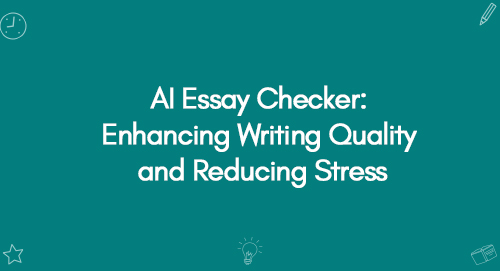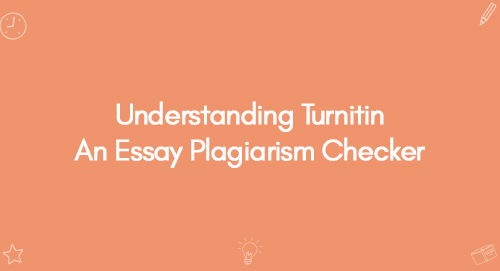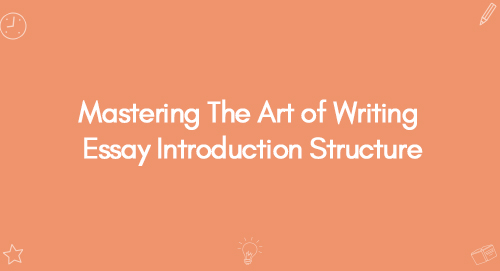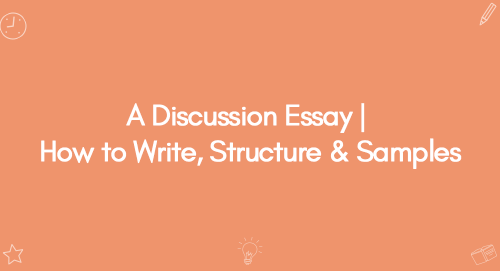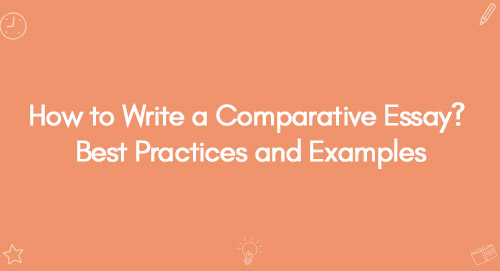How to Write a Comparative Essay? Best Practices and Examples
How to Write a Comparative Essay? Best Practices and Examples

The Anatomy of an Essay: How to Structure Your Essay for Maximum Impact?
October 13, 2022
How to Write a Descriptive Essay?
October 17, 2022When asked how to write a comparative essay, many students immediately think about comparing two things. However, comparative essays can compare anything - two people, two places, two events, or even two ideas. The key to writing a successful comparative essay is to find a way to compare two things that are both meaningful and interesting.
For example, you could compare how two authors approach the same topic. Or you could compare the experience of living in two cities. As long as you can find a way to draw meaningful comparisons between your chosen subjects, you should be able to write an effective comparative essay.
In this blog, we will learn how to write a comparative essay with examples.
Definition of a comparative essay
Comparative refers to a measurement or evaluation that compares and contrasts the subjects being evaluated. Thus, a comparative essay is one in which the author must typically compare two related issues in terms of similarities and differences. The problems may be closely related or entirely dissimilar.
Organizing and Structuring the Comparative Essay
Initially, create a draft which will help you follow the pathway to structure and organize your essay appropriately; the task can involve the following:
- Choose a topic.
- Research your topic.
- Develop a thesis statement.
- Outline your essay.
- Introduce your topic in your essay's introduction.
- Discuss the first subject in the body of your essay.
- Discuss the second subject in the body of your essay.
- Compare and contrast the two subjects in the body of your essay.
- Conclude the two subjects in the conclusion of your essay.
- Edit and proofread your essay before submitting it.
Choose a topic that you are familiar with.
One of the best ways to write a comparative essay is to choose a topic you are familiar with. It will offer you an excellent foundation to work from, and you will be able to draw on your own experiences and knowledge to support your arguments.
Make a list of the similarities and differences between the two subjects.
Once you have chosen a topic, list the similarities and differences between the two subjects. That will help you see the big picture and identify the essential points you must address in your essay.
Use ideal comparative essay structure.
Comparative essay writing is a tricky business; one key component is comparative essay structure. One common approach is to discuss the similarities between the two subjects before discussing their differences. Alternatively, you could discuss the differences between the two subjects before discussing their similarities. Whichever approach you choose, make sure that what you are doing to your reader is clear.
Introduce your topic and state your thesis.
In the introduction of your comparative essay, you should provide some background information on your topic and state your thesis statement. Your thesis statement should briefly summarize your main argument or point of comparison.
Compare and contrast the two subjects in each body paragraph.
In each body paragraph, compare and contrast the two subjects in detail. Make sure to address the similarities and differences between the subjects in each paragraph.
Use transitional words and phrases to help readers follow your argument.
Transitional words and phrases can be beneficial in a comparative essay as they can help to clarify your argument and keep track of where you are in the comparison. Some common transitional words and phrases include: "in contrast," "on the other hand," "similarly," "likewise," "however," and "nevertheless."
Draw conclusions based on your comparisons.
Once you have finished comparing and contrasting the two subjects, you should draw conclusions based on your findings. What did you learn from comparing these two things? What are some of the implications of your findings? Be sure to answer these questions in your conclusion section.
Check this blog to learn how to write conclusion for your essay.
Revise your essay
Leaving your work alone for a day is the greatest revision method. When you sit down to revise, remember that identifying and fixing issues are the two most crucial tasks. These should be completed independently (i.e., Find as many errors as you can without correcting them, then go over the document again to fix them.). Although it may be tempting to do them all at once, it is wiser to complete them one at a time. This will guarantee that everything has been checked and will eventually speed up and improve the effectiveness of the task.
Free Premier Essay Writing Topics
Essay Writing is an essential part of academics which presents the ideas, arguments, opinions, or positions of the writer regarding the topic. The writer supports his claims using facts, evidence, or survey studies.
- Clear presentation or understanding of the type of essay
- An appealing introduction with an unambiguous thesis statement
- A well-defined structure of body paragraphs supporting the thesis
A prospective conclusion with an optimistic tone
Examples of Comparative Essays
Example no. 1: A Comparison of the Efficacy of Traditional Methods of Infantile Colic Relief Alongside Manuel Treatment: A Literature Review
This essay compares the efficacy of various methods of curing infantile colic relief. The essay uses comparative writing techniques to elaborate and compare the pros and cons of various curing methods.
Example No. 2: How Does the Use of Psychodynamic Therapy in Comparison to Medication Help in Treating Depression in Teenagers?
This essay is a comparative study of depression cures. It analyses the effects and side effects of modern medicine and psychodynamic therapy on teenagers. The assessment is based on a detailed literature review which synthesises findings from different published researches. The essay is divided into three different sections; introduction, main review and conclusion along with the summary table of the published articles used for explaining the review.
Example no. 3: Emotional Intelligence and Leadership
This example of comparative essay deals with and describes the correlation as well as the importance of EQ and leadership in modern business landscape. The impact of each can be assessed and measured with research. This essay compares the impact of both key factors in modern decision-making grids.

7 Major Steps Used to Write a Comparative Essay
The below steps will assist in writing a compare and contrast essay in a constructive way.
-
Determine the Basis for Comparison
Take time to read the topic of your paper to identify what you will be comparing with it, and do this throughout the paper. If it is not specified as the basis of the assignment and you are allowed to pick yours, select at least three points of comparison. Determine if there is a need to assess a broad comparison or specific analysis of the assignment.
-
Become Familiar with the Source Materials
Where your course provides sources, in this case, for the topics, make sure you read them for your topic. First, where the course needs to allocate reading material, research what you are studying. The resources should include books or journal articles that deal with various themes of the comparison essays; they will serve as a foundation. Carefully read it, and note down any significant idea or observation.
-
Select an Appropriate Structure
The structure in a comparative essay refers to how you organise your paper's body paragraphs. There are three kinds of structures for this type of essay:
- Block structure
This block structure is subject-based and explores some critical issues on each subject before proceeding with another. It might be reasonable enough when more than a couple of subjects are being assessed and when it is realised that there are very few similarities between them. Ensure that your thesis is not portrayed as an essay of two subjects. This will go a long way in making your comparative essay more flowing and unified.
- Alternating structure
Alternating structure deals point by point with an aspect that compares your subjects concerning one point each time. This works well for subjects having a minimum of three related points.
- Woven structure
It is worth noting that the woven design compares subjects to an angle in the same paragraph. Consider employing this method where you only talk about two closely related points with two different cases. Switching between subjects is the essence of this structure. In this case, consider using linking words such as prepositions and phrases to ease the transitions. Alternatively, formulate a single sentence discussing their commonalities and contrasts.
-
Design an Outline for a Comparative Essay
Make a compare and contrast essay outline, including items about common features and dissimilarities among sources you have considered during your research. The structure of your essay should include an introduction, a body and a conclusion. Use bullet points and keywords to draw your emphasis into the chief points. Discuss each of the points and its elements by sections.
-
Write an Introduction that Contains your Thesis Statement
The main topic of your comparative essay should be indicated in your introductory paragraph. Your topic should have some grounding to aid in making comparisons. After that, you will say that your paper aims to compare and contrast significant characteristics of the issues. Ensure that you have included a thesis statement in your introductory paragraph to show the essence of your writing and why you chose the basis of comparison.
-
Write the Body of your Essay
Body paragraphs should mirror your outline. Wherever possible, make sure you include at least three points of comparison. Start every paragraph by presenting a new topic statement and lead them into the major point that will be dealt with in that paragraph. Likewise, discuss similarities between these things. For example, if you have highlighted three similarities among them, then discuss two of the differences in the same order.
-
Write a Conclusion Summarising your Main Points.
Briefly state the key arguments in your final paragraph. Wrap up your essay with a conclusive statement that commands attention.
Methods to develop the comparative essay structure
The most challenging aspect of a compare-and-contrast essay structure is deciding when to discuss which topic. You essentially have three choices:
- Subject-By-Subject Block Method:
After thoroughly covering one topic, you go on to the next.
- Alternating Method (point-by-point):
You describe one subject's perspective on a particular aspect, then another subject's perspective follows right after, and then you cover a brand-new aspect.
- Similarity and Difference:
You go over all the similarities between subjects before moving on to the differences or the opposite (differences first and then similarities).
You must pay close attention to the main sentences regardless of your choice. In comparison and contrast essays, the paragraphs might get complex; therefore, it's crucial to have a strong topic or introductory statement for each paragraph to ensure that the ideas flow smoothly.
Block Method
Although quite risky, this approach is the most straightforward. The fundamental idea here is to split the essay into two halves. One subject will be covered in the first portion, while another one in the second. Accordingly, subject one and all the elements of comparison involved are explained in the first portion, while subject two is the only topic covered in the second.
Alternating Method
This approach covers the comparison-related topic in detail in a single paragraph. This implies that one point of comparison regarding the first subject is explained in detail using a whole paragraph.
After that, another paragraph will deal with the second issue but still thoroughly discusses the same element.
This means that the first and second paragraphs, although discussing the first and second subjects, respectively, describe the same feature of comparison.
As a result, the third and fourth paragraphs will each cover a different feature of the first and second subjects, respectively. This pattern continues till the essay's conclusion.
Similarities and differences
With each topic being presented in the same paragraph, the third method is pretty similar to the alternating strategy. However, the paragraphs are not split into various topics but rather by the similarities and differences between the issues.
This approach is most effective when you want to concentrate on a specific resemblance or difference between your subjects or when you want to build to a dramatic conclusion or revelation at the end.
Tips for crafting an effective comparative essay
The following two tips are true north of comparative essay writing. Follow these and you will ace your comparative essay.
Consider relevant topics
Pick topics with a lot in common, or your essay will just compare and contrast. In comparative essays, the subjects typically have a close relationship, such as two persons in the same profession or two things belonging to the same category.
The reader is left thinking, "What's the point of contrasting these two things?" without this connecting topic. It won't just confuse your readers; it will also make it harder for you to write coherently. Wisely selecting your topic at the outset may prevent these issues from arising.
Write to clarify
Imagine how confused essays with two or more subjects become. Communicating correctly so your reader understands which arguments connect to which subjects and what conclusion the whole essay is developing toward are one of the significant challenges with compare-and-contrast essays.
Conclusion
While drafting your essay, there will always be a few mistakes you might not see. When you have finished everything and have some time before submitting your project, check it over to ensure there aren't any mistakes that might affect your result. I hope this blog has covered all your ambiguities on how to write a comparative essay. If you need help with comparative essay writing contact Premier Essays.
An Example of a Comparative Essay
Here is a correlative example of a compare and contrast essay.
Title: A Comparative Analysis of Traditional Education and Online Learning
Education is an important aspect of human development, and over the years, various modes of learning have evolved to meet the diverse needs of students. Traditional education, rooted in centuries-old practices, has long been the predominant form of learning. However, the rise of technology has given birth to online learning, presenting an alternative that challenges the traditional model. This article consists of a comparison of traditional education against online learning, focusing on the aspects that include accessibility, social relations and flexibility.
In a traditional classroom setting, students must be physically present at a specific location, which can be a barrier for those with geographical distance or physical disabilities. This limitation can stop the educational opportunities for many of the population. Whereas online platforms break down geographical barriers, providing access to education for individuals worldwide. This accessibility makes it conducive because students can join courses and programmes which could otherwise be inaccessible or inconvenient.
In traditional education, fixed schedules, with classes conducted at specific times and locations, define traditional education. This structure may provide a sense of routine but can be challenging for individuals with other commitments, such as work or family responsibilities. Flexibility is one of the key features of online learning, where students can access study materials and submit their assignments anytime. Such a feature is meant for the convenience of employees, parents and people without a fixed schedule.
To sum up, one's preference, occasion or reason for learning, and personal objective determine whether he/she opts for a conventional or online education. Traditional education is very immersive and interactive, while online learning is convenient, providing flexibility to the student. As education continues to evolve, a hybrid approach that combines the strengths of both models may offer a balanced solution, catering to the needs of a globalised and technologically advanced society. The effectiveness of any educational model lies in its ability to empower learners, fostering intellectual growth and personal development.
Conclusion
One can write compare-and-contrast essays on various subjects, for instance, literature, history, science, etc. The purpose is to investigate correlations among these topics and obtain insightful inferences from the study. Critical thinking is encouraged, allowing an intensive examination of the commonalities and contrasts between various aspects. All the mentioned resources help improve the writing quality, and thus, they can be used in comparison essays or any other type of essay.
References
- The comparative essay. (n.d.). Writing Advice | University of Toronto.
- George, K. (2023, March 9). How to write a comparative essay: Structure & tips. A Team Tuition.
- How to write a comparative essay (with pictures). (2005, October 4). wikiHow.
- Indeed Career development... (n.d.).
Research guides: How to write a comparison essay: Introduction. (2019, August 19). Research Guides at Langara College.


